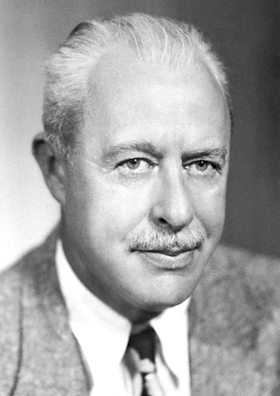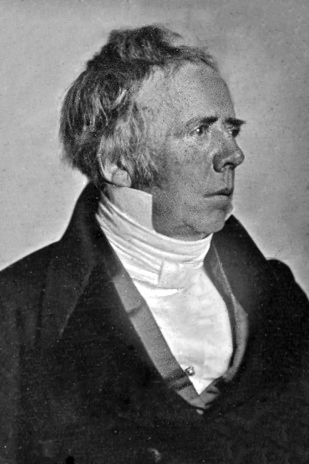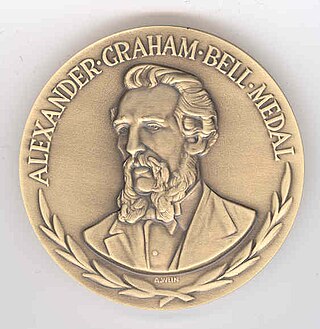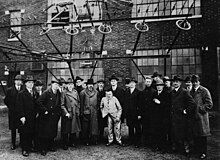
Charles Proteus Steinmetz was an American mathematician and electrical engineer and professor at Union College. He fostered the development of alternating current that made possible the expansion of the electric power industry in the United States, formulating mathematical theories for engineers. He made ground-breaking discoveries in the understanding of hysteresis that enabled engineers to design better electromagnetic apparatus equipment, especially electric motors for use in industry.

Walter Houser Brattain was an American physicist at Bell Labs who, along with fellow scientists John Bardeen and William Shockley, invented the point-contact transistor in December 1947. They shared the 1956 Nobel Prize in Physics for their invention. Brattain devoted much of his life to research on surface states.

Robert Andrews Millikan was an American experimental physicist who won the Nobel Prize for Physics in 1923 for the measurement of the elementary electric charge and for his work on the photoelectric effect.

The Enrico Fermi Award is a scientific award conferred by the President of the United States. It is awarded to honor scientists of international stature for their lifetime achievement in the development, use or production of energy. It was established in 1956 by the Atomic Energy Commission in memorial of Italian-American physicist Enrico Fermi and his work in the development of nuclear power. The award has been administered through the Department of Energy since its establishment in 1977. The recipient of the award receives $100,000, a certificate signed by the President and the Secretary of Energy and a gold medal featuring the likeness of Enrico Fermi.
William Allan Wulf was an American computer scientist notable for his work in programming languages and compilers.

The Oersted Medal recognizes notable contributions to the teaching of physics. Established in 1936, it is awarded by the American Association of Physics Teachers. The award is named for Hans Christian Ørsted. It is the Association's most prestigious award.

Vale Cemetery is a historic rural cemetery and the largest cemetery in Schenectady, New York. It opened on 21 October 1857, when the Rev. Julius Seely dedicated what was then termed "the Vale". It has tripled its size since opening and today it holds the remains of some of the most notable persons in Upstate New York. In 1973, a 35-acre tract of unused and abandoned cemetery land around the ponds of Cowhorn Creek was sold to the city of Schenectady to form Vale Park.
The American Association for the Advancement of Science (AAAS), founded in 1848, is the world's largest general scientific society. It serves 262 affiliated societies and academies of science and engineering, representing 10 million individuals worldwide. It is publisher of the journal Science, which has the largest paid circulation of any peer-reviewed general science journal in the world and an estimated total readership of 1 million. AAAS fulfills its mission to "advance science and serve society" through initiatives in science policy; international programs; science education; communication; and more. It is a non-profit organization, with membership open to everyone.
Steinmetz/Steynmets is a German surname, meaning 'stonemason'. It may refer to:

Ernst Julius Berg was a Swedish-born, American electrical engineer.

Esther Marley Conwell was a pioneering American chemist and physicist, best known for the Conwell-Weisskopf theory that describes how electrons travel through semiconductors, a breakthrough that helped revolutionize modern computing. During her life, she was described as one of the most important women in science.
The IEEE Edison Medal is presented by the Institute of Electrical and Electronics Engineers (IEEE) "for a career of meritorious achievement in electrical science, electrical engineering, or the electrical arts." It is the oldest medal in this field of engineering. The award consists of a gold medal, bronze replica, certificate, and honorarium. The medal may only be awarded to a new leap/breakthrough in the technological area of science.

The IEEE Medal of Honor is the highest recognition of the American Institute of Electrical and Electronics Engineers (IEEE). It has been awarded since 1917, and is given to an individual for an exceptional contribution or an extraordinary career in the IEEE fields of interest. The award consists of a gold medal, a bronze replica, a certificate, and an honorarium.

The IEEE Alexander Graham Bell Medal is an award honoring "exceptional contributions to communications and networking sciences and engineering" in the field of telecommunications. The medal is one of the highest honors awarded by the Institute of Electrical and Electronics Engineers (IEEE) for achievements in telecommunication sciences and engineering.
The IEEE Charles Proteus Steinmetz Award is a technical field award given to an individual by the Institute of Electrical and Electronics Engineers (IEEE), for major contributions to standardization within the field of electrical and electronics engineering. This IEEE-level award, which honors Charles Proteus Steinmetz, was created in 1979 by the board of directors of the IEEE and sponsored by the IEEE Standards Association.
The initially called Morris Liebmann Memorial Prize provided by the Institute of Radio Engineers (IRE), the IEEE Morris N. Liebmann Memorial Award was created in 1919 in honor of Colonel Morris N. Liebmann. It was initially given to awardees who had "made public during the recent past an important contribution to radio communications". The award continued to be awarded as the IEEE Morris N. Liebmann Memorial Award by the board of directors of the Institute of Electrical and Electronics Engineers (IEEE) after the IRE organization merged into the IEEE in 1963. The scope was changed to "for important contributions to emerging technologies recognized within recent years". After 2000, the award was superseded by the IEEE Daniel E. Noble Award.
Hollis Leland Caswell was an American educator who became an authority on curriculum planning in schools. He directed surveys of curriculum practices in several school systems, and wrote several books on the subject.

The United States Navy Memorial presents a Lone Sailor Award to Sea Service veterans who have excelled with distinction in their respective careers during or after their service. The award recipients will join a list of men and women who have distinguished themselves by drawing upon their military experience to become successful in their subsequent careers and lives, while exemplifying the core values of Honor, Courage and Commitment. The Lone Sailor Award has been given out each year since the Navy Memorial was dedicated in 1987.

Harold Glenn Moulton was an American economist and longtime fellow at the Brookings Institution. He authored several dozen books and papers exploring timely social and economic topics, including "Waterways versus Railways" (1912), "The Principles of Money and Banking" (1916), "Germany's Capacity to Pay" (1923), "The Reparation Question" (1924), "The Formation of Capital" (1935), "Control of Germany and Japan" (1944), and "Can Inflation be Controlled?" (1958).















